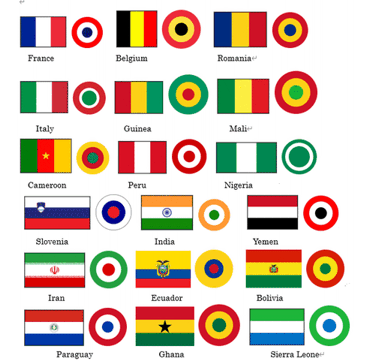
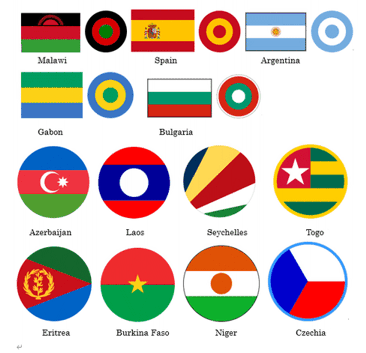 images by Nozomi Kariyasu, 30 May 2024
images by Nozomi Kariyasu, 30 May 2024
Last modified: 2025-05-03 by rob raeside
Keywords: aircraft roundels | fin flashes |
Links: FOTW homepage |
search |
disclaimer and copyright |
write us |
mirrors
Other sites:
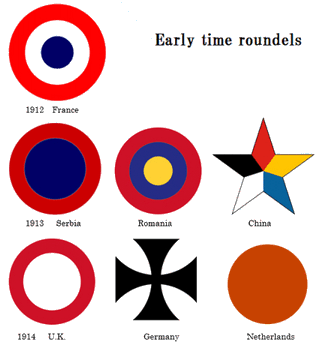 images by Nozomi Kariyasu, 26 June 2024
images by Nozomi Kariyasu, 26 June 2024

 images by Nozomi Kariyasu, 30 May 2024
images by Nozomi Kariyasu, 30 May 2024
France began the first Air Service in 1909 and soon picked the traditional
French cockade as the first national emblem, now usually termed a roundel, on
military aircraft. During World War I, other countries adopted national
cockades and used these coloured emblems as
roundels on their military aircraft. These designs often bear an additional
central device or emblem to further identify national aircraft, those from the
French navy bearing a black anchor within the French cockade.
Source:
https://en.m.wikipedia.org/wiki/Cockade (which un turn Is based on: (1996).
"The U.S. Air Service in the Great War, 1917-1919". Praeger. p. 202. ISBN
9780275948627").
The cockade was the precursor of many national flags
(those of Argentina and France being two examples).
Esteban Rivera,
31 May 2024
The origin of roundels is found in the French cocarde. As seen in
this illustration, an example with
Venezuelan colors, made by Adolfo Alonzo (source),
it is simply the extension of the national colours "wrapped" into a
rosette or cockade which
in turn derives into a roundel (in the example, the Venezuelan
flag).
During the early expansion of aviation (early XXth century) several attempts were made at adopting a standard
protocol for identification purposes as follows: "The concept of nationality
for aircraft was adapted from maritime law where the national flag is used to
indicate a ship’s country of registration. The questions related to technical
and legal aspects relevant for the future of aviation, among which was that
of aircraft registration, were considered at the Paris Conference of 1910.
While this Conference was unsuccessful in that it did not result in a signed
agreement, the draft it produced subsequently formed the basis for the 1919
Paris Conference. The First Commission of the latter Conference, that dealt,
among other things, with the registration of aircraft, came up in Annex A -
Registration of Aircraft with a list of nationality marks for the
participating countries; it is to be noted that the identification with one
letter for five countries was based on the call sign prefixes adopted by the
1912 Radiotelegraph Conference, held in London. The intention being that
other states adopting later the Convention Relating to the Regulation of
Aerial Navigation should inform the International Commission for Air
Navigation (ICAN) of the nationality mark chosen. The Commission would act as
the coordinating body, ensuring that they did not duplicate those already
allocated."
(source:
https://applications.icao.int/postalhistory/annex_7_aircraft_nationality_and_registration_marks.htm).
The issue of man-made flight took a new turn on November 21, 1783 when
the first free flight carrying a human occurred in Paris, France. "The French
Montgolfier Brothers (Joseph-Michel and Jacques-Étienne) made a balloon (now
described as lighter-than-air aircraft) from paper and silk. It carried two
men, Francois Pilate de Rozier and Francois Laurent, Marquis of d’Arlanders.
This followed by the implementation of this new technology for military
applications with the birth of the "Compagnie d'aérostiers" (Company
of Aeronauts) in 1794 (source). It was not
until almost 100 years later that another milestone was reached, this time by
French Engineer Henri Giffard tethered a massive balloon that was installed in
the courtyard of the Tuileries during the Paris World's Fair of 1878 during which
it
carried 35,000 passengers, as rides were offered during the Fair." (source)
In chronological order the first countries (pre WWI) to adopt roundels
for aircraft (airplanes, airships and/or balloons) identification were France, Serbia, Romania,
China (1913), UK, Germany, the Netherlands (1914).
Since
the French were then the first to adopt this graphical application to their
hardware, they were most likely the first to issue official documents on how
to regulate this practice, as seen in this document,
dated April 22, 1916 (source/) by the "Service technique de l'aéronautique, STAé" (Aeronautical
Technical Service) (1916-1980), a French state body responsible for
coordinating technical aspects of aviation in France. In 1877 l'Établissement
central de l'aérostation militaire de Chalais-Meudon ((the) Central
Establishment of the air balloon of Chalais- Meudon) was formed as the first
aeronautical laboratory in the world, with a mission to design and assemble
all French military aero-static equipment, from components made in industry,
and train personnel in their use.
In the above-mentioned document the STAé labels this images as "Marques
distinctives" (Distinctive marks).
Around the 1930s onwards,
this topic (flags and identification badges, e.g. RAF Badges) became a popular
thing, especially thanks to cigarette cards, as well as some appearances on
philately.
The Supplement to ICAO Annex 7 provides information with regards to
differences between the national regulations and practices of Contracting
States and the corresponding international standards contained in Annex 7; it
also provides the list of aircraft nationality marks, national emblems and
common marks. In modern times interest has grown also thanks
to scale (miniature) modelists and illustrators of aircraft profiles alike.
Esteban Rivera, 13 June 2024
When nationality markings were first applied to military aircraft, vertical fin flashes with the national flag design were attached to the rudder, but later they were also attached to the vertical tail fins.
Of the countries currently using fin flashes, half of all countries use horizontal flag designs, including Turkey, South Africa, Canada, and Germany.
The second most common type is the vertical fin flash, which is in the colors of the national flag and is attached to the vertical tail and rudder. Australia, New Zealand, and the United Kingdom all use the three colors of the national flag, red, white, and blue, but distinguish them by changing the number of colors used and the width of the stripes. India, like New Zealand, uses a fin flash with a narrower stripe in the middle.
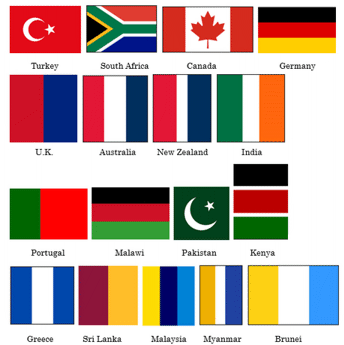
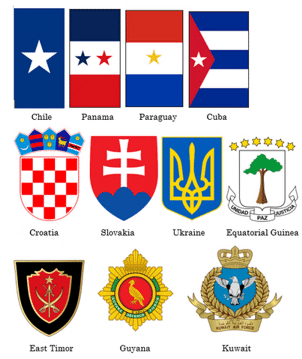 images by Nozomi Kariyasu, 13 June 2024
images by Nozomi Kariyasu, 13 June 2024
Several countries use simplified flags as a fin flash.
Some of the fin flashes, which are just an array of colors, are difficult to identify which country they are from.
Many Latin American countries have stars on their fin flashes as well as on their national flags.
Next, there are several countries that use the shield-shaped national coat of arms as a fin flash.
Countries using military or air force insignia are East Timor, Guyana, and Kuwait.
Nozomi Kariyasu, 13 June 2024
Here's my analysis of how flags are represented in roundels
Vertical bi- and tricolours, hoist in centre: 12
Fly in centre: 4
Horizontal bi- tri- and quadricolours, lower in centre: 28
Top in Centre: 4
In addition, [Republic of the] Congo puts the upper hoist of its diagonal tricolour in the centre, while Katanga (Democratic Republic of Congo 1960-62) put the lower fly in the centre.
Almost every national marking alludes to the national flag; as can be seen above, many use simple circular roundels (including many not listed here), also, a number of nations have simply painted their national flags in a circular shape (Niger, Eritrea, Czech Republic).
The markings which have the least relation to the national flag include Germany, Lithuania, and Iraq. Canada, Australia and New Zealand have all adapted the British roundel; at least Australia and New Zealand use their flag colours, while the Canadian roundel was adopted when the country still used the Red Ensign and Union Jack (and since 1965 the leaf on the roundel matches the flag).
1 reversed design at some point (not included in totals).
2 not simple "roundels", but some other shape (triangular, pentagonal, etc.).
Dean McGee, 4 January 2012